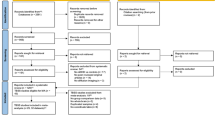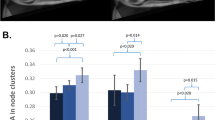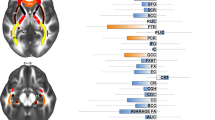Abstract
Changes in cerebral cortical anatomy have been tied to the clinical course of attention deficit hyperactivity disorder (ADHD). We now ask if alterations in white matter tract microstructure are likewise linked with the adult outcome of childhood ADHD. Seventy-five young adults, 32 with ADHD persisting from childhood and 43 with symptom remission were contrasted against 74 never-affected comparison subjects. Using diffusion tensor imaging, we defined fractional anisotropy, a metric related to white matter microstructure, along with measures of diffusion perpendicular (radial) and parallel (axial) to the axon. Analyses were adjusted for head motion, age and sex, and controlled for multiple comparisons and medication history. Tract-based analyses showed that greater adult inattention, but not hyperactivity–impulsivity, was associated with significantly lower fractional anisotropy in the left uncinate (standardized β=−0.37, t=3.28, p=0.002) and inferior fronto-occipital fasciculi (standardized β=−0.37, t=3.29, p=0.002). The ADHD group with symptoms persisting into adulthood had significantly lower fractional anisotropy than the never-affected controls in these tracts, differences associated with medium to large effect sizes. By contrast, the ADHD group that remitted by adulthood did not differ significantly from controls. The anomalies were found in tracts that connect components of neural systems pertinent to ADHD, such as attention control (inferior fronto-occipital fasciculus) and emotion regulation and the processing of reward (the uncinate fasciculus). Change in radial rather than axial diffusivity was the primary driver of this effect, suggesting pathophysiological processes including altered myelination as future targets for pharmacological and behavioral interventions.
Similar content being viewed by others
Log in or create a free account to read this content
Gain free access to this article, as well as selected content from this journal and more on nature.com
or
References
Basser PJ, Mattiello J, LeBihan D (1994). Estimation of the effective self-diffusion tensor from the NMR spin echo. J Magn Reson B 103: 247–254.
Basser PJ, Pierpaoli C (1996). Microstructural and physiological features of tissues elucidated by quantitative-diffusion-tensor MRI. J Magn Reson B 111: 209–219.
Birnbaum HG, Kessler RC, Lowe SW, Secnik K, Greenberg PE, Leong SA et al (2005). Costs of attention deficit-hyperactivity disorder (ADHD) in the US: excess costs of persons with ADHD and their family members in 2000. Curr Med Res Opin 21: 195–205.
Bongarzone ER, Howard SG, Schonmann V, Campagnoni AT (1998). Identification of the dopamine D3 receptor in oligodendrocyte precursors: potential role in regulating differentiation and myelin formation. J Neurosci 18: 5344–5353.
Casey B, Durston S (2006). From behavior to cognition to the brain and back: what have we learned from functional imaging studies of attention deficit hyperactivity disorder? Am J Psychiatry 163: 957–960.
Casey BJ, Epstein JN, Buhle J, Liston C, Davidson MC, Tonev ST et al (2007). Frontostriatal connectivity and its role in cognitive control in parent-child dyads with ADHD. Am J Psychiatry 164: 1729–1736.
Castellanos FX, Proal E (2012). Large-scale brain systems in ADHD: Beyond the prefrontal-striatal model. Trends Cogn Sci 16: 17–26.
Clerkin SM, Schulz KP, Berwid OG, Fan J, Newcorn JH, Tang CY et al (2013). Thalamo-cortical activation and connectivity during response preparation in adults with persistent and remitted ADHD. Am J Psychiatry 170: 1011–1019.
Coghill D, Hayward D, Rhodes S, Grimmer C, Matthews K (2014). A longitudinal examination of neuropsychological and clinical functioning in boys with attention deficit hyperactivity disorder (ADHD): improvements in executive functioning do not explain clinical improvement. Psychol Med 44: 1087–1099.
Cole W, Mostofsky S, Larson JG, Denckla M, Mahone E (2008). Age-related changes in motor subtle signs among girls and boys with ADHD. Neurology 71: 1514–1520.
Cortese S, Imperati D, Zhou J, Proal E, Klein RG, Mannuzza S et al (2013). White matter alterations at 33-year follow-up in adults with childhood attention-deficit/hyperactivity disorder. Biol Psychiatry 74: 591–598.
Doricchi F, Thiebaut de Schotten M, Tomaiuolo F, Bartolomeo P (2008). White matter (dis)connections and gray matter (dys)functions in visual neglect: Gaining insights into the brain networks of spatial awareness. Cortex 44: 983–995.
DuPaul GJ, Power JD, Anastopouls AA, Reid R (1998) ADHD Rating Scale-IV: Checklists, Norms and Clinical Interpretation. The Guilford Press: New York, NY, USA.
Durston S, Fossella J, Casey B, Hulshoff Pol H, Galvan A, Schnack H et al (2005). Differential effects of DRD4 and DAT1 genotype on fronto-striatal gray matter volumes in a sample of subjects with attention deficit hyperactivity disorder, their unaffected siblings, and controls. Mol Psychiatry 10: 678–685.
Durston S, van Belle J, de Zeeuw P (2011). Differentiating frontostriatal and fronto-cerebellar circuits in attention-deficit/hyperactivity disorder. Biol Psychiatry 69: 1178–1184.
Epelbaum S, Pinel P, Gaillard R, Delmaire C, Perrin M, Dupont S et al (2008). Pure alexia as a disconnection syndrome: new diffusion imaging evidence for an old concept. Cortex 44: 962–974.
Faraone SV, Biederman J, Mick E (2006). The age-dependent decline of attention deficit hyperactivity disorder: a meta-analysis of follow-up studies. Psychol Med 36: 159–165.
Franke B, Vasquez AA, Johansson S, Hoogman M, Romanos J, Boreatti-Hummer A et al (2010). Multicenter analysis of the SLC6A3/DAT1 VNTR haplotype in persistent ADHD suggests differential involvement of the gene in childhood and persistent ADHD. Neuropsychopharmacology 35: 656–664.
Halperin JM, Schulz KP (2006). Revisiting the role of the prefrontal cortex in the pathophysiology of attention-deficit/hyperactivity disorder. Psychol Bull 132: 560–581.
Joseph B, Dyer CA (2003). Relationship between myelin production and dopamine synthesis in the PKU mouse brain. J Neurochem 86: 615–626.
Klawiter EC, Schmidt RE, Trinkaus K, Liang H-F, Budde MD, Naismith RT et al (2011). Radial diffusivity predicts demyelination in ex vivo multiple sclerosis spinal cords. Neuroimage 55: 1454–1460.
Konrad A, Dielentheis TF, El Masri D, Bayerl M, Fehr C, Gesierich T et al (2010a). Disturbed structural connectivity is related to inattention and impulsivity in adult attention deficit hyperactivity disorder. Eur J Neurosci 31: 912–919.
Konrad K, Eickhoff SB (2010b). Is the ADHD brain wired differently? A review on structural and functional connectivity in attention deficit hyperactivity disorder. Hum Brain Mapp 31: 904–916.
Liston C, Cohen MM, Teslovich T, Levenson D, Casey B (2011). Atypical prefrontal connectivity in attention-deficit/hyperactivity disorder: pathway to disease or pathological end point? Biol Psychiatry 69: 1168–1177.
Mackie S, Shaw P, Lenroot R, Pierson R, Greenstein DK, Nugent TF 3rd et al (2007). Cerebellar development and clinical outcome in attention deficit hyperactivity disorder. Am J Psychiatry 164: 647–655.
Makris N, Buka SL, Biederman J, Papadimitriou GM, Hodge SM, Valera EM et al (2008). Attention and executive systems abnormalities in adults with childhood ADHD: a DT-MRI study of connections. Cereb Cortex 18: 1210–1220.
Mattfeld AT, Gabrieli JD, Biederman J, Spencer T, Brown A, Kotte A et al (2014). Brain differences between persistent and remitted attention deficit hyperactivity disorder. Brain 137 (Pt 9): 2423–2428.
Moeller FG, Hasan KM, Steinberg JL, Kramer LA, Dougherty DM, Santos RM et al (2004). Reduced anterior corpus callosum white matter integrity is related to increased impulsivity and reduced discriminability in cocaine-dependent subjects: diffusion tensor imaging. Neuropsychopharmacology 30: 610–617.
Mostofsky SH, Rimrodt SL, Schafer JG, Boyce A, Goldberg MC, Pekar JJ et al (2006). Atypical motor and sensory cortex activation in attention-deficit/hyperactivity disorder: a functional magnetic resonance imaging study of simple sequential finger tapping. Biol Psychiatry 59: 48–56.
Nagel BJ, Bathula D, Herting M, Schmitt C, Kroenke CD, Fair D et al (2011). Altered white matter microstructure in children with attention-deficit/hyperactivity disorder. J Am Acad Child Adolesc Psychiatry 50: 283–292.
Nagy Z, Westerberg H, Klingberg T (2004). Maturation of white matter is associated with the development of cognitive functions during childhood. J Cogn Neurosci 16: 1227–1233.
Nigg JT, Casey BJ (2005). An integrative theory of attention-deficit/hyperactivity disorder based on the cognitive and affective neurosciences. Dev Psychopathol 17: 785–806.
Oechslin MS, Imfeld A, Loenneker T, Meyer M, Jäncke L (2009). The plasticity of the superior longitudinal fasciculus as a function of musical expertise: a diffusion tensor imaging study. Front Hum Neurosci 3: 76.
Pfefferbaum A, Sullivan EV (2004). Disruption of brain white matter microstructure by excessive intracellular and extracellular fluid in alcoholism: evidence from diffusion tensor imaging. Neuropsychopharmacology 30: 423–432.
Pierpaoli C, Walker L, Irfanoglu M, Barnett A, Basser P, Chang L et al (2010). TORTOISE: an integrated software package for processing of diffusion MRI data. ISMRM 18th Annual Meeting, Stockholm, Sweden, #1597.
Pingault JB (2011). Childhood trajectories of inattention and hyperactivity and prediction of educational attainment in early adulthood: a 16-year longitudinal population-based study. Am J Psychiatry 168: 1164.
Plessen KJ, Bansal R, Zhu H, Whiteman R, Amat J, Quackenbush GA et al (2006). Hippocampus and amygdala morphology in attention-deficit/hyperactivity disorder. Arch Gen Psychiatry 63: 795–807.
Proal E, Reiss PT, Klein RG, Mannuzza S, Gotimer K, Ramos-Olazagasti MA et al (2011). Brain gray matter deficits at 33-year follow-up in adults with attention-deficit/hyperactivity disorder established in childhood. Arch Gen Psychiatry 68: 1122–1134.
Rajendran K, Rindskopf D, O’Neill S, Marks DJ, Nomura Y, Halperin JM (2013). Neuropsychological functioning and severity of ADHD in early childhood: A four-year cross-lagged study. J Abnorm Psychol 122: 1179.
Reich W (2000). Diagnostic interview for children and adolescents (DICA). J Am Acad Child Adolesc Psychiatry 39: 59–66.
Shaw P, Gornick M, Lerch J, Addington A, Seal J, Greenstein D et al (2007). Polymorphisms of the dopamine d4 receptor, clinical outcome, and cortical structure in attention-deficit/hyperactivity disorder. Arch Gen Psychiatry 64: 921–931.
Shaw P, Malek M, Watson B, Greenstein D, de Rossi P, Sharp W (2013). Trajectories of cerebral cortical development in childhood and adolescence and adult attention-deficit/hyperactivity disorder. Biol Psychiatry 74: 599–606.
Shaw P, Stringaris A, Nigg J, Leibenluft E (2014). Emotion dysregulation in attention deficit hyperactivity disorder. Am J Psychiatry 171: 276–293.
Smith SM, Jenkinson M, Johansen-Berg H, Rueckert D, Nichols TE, Mackay CE et al (2006). Tract-based spatial statistics: voxelwise analysis of multi-subject diffusion data. Neuroimage 31: 1487–1505.
Song S-K, Sun S-W, Ramsbottom MJ, Chang C, Russell J, Cross AH (2002). Dysmyelination revealed through MRI as increased radial (but unchanged axial) diffusion of water. Neuroimage 17: 1429–1436.
Song S-K, Yoshino J, Le TQ, Lin S-J, Sun S-W, Cross AH et al (2005). Demyelination increases radial diffusivity in corpus callosum of mouse brain. Neuroimage 26: 132–140.
Sonuga-Barke EJ (2005). Causal models of attention-deficit/hyperactivity disorder: from common simple deficits to multiple developmental pathways. Biol Psychiatry 57: 1231–1238.
Tamnes CK, Fjell AM, Westlye LT, Østby Y, Walhovd KB (2012). Becoming consistent: developmental reductions in intraindividual variability in reaction time are related to white matter integrity. J Neurosci 32: 972–982.
Tang Y-Y, Lu Q, Fan M, Yang Y, Posner MI (2012). Mechanisms of white matter changes induced by meditation. Proc Natl Acad Sci USA 109: 10570–10574.
Tuch DS, Salat DH, Wisco JJ, Zaleta AK, Hevelone ND, Rosas HD (2005). Choice reaction time performance correlates with diffusion anisotropy in white matter pathways supporting visuospatial attention. Proc Natl Acad Sci USA 102: 12212–12217.
van Ewijk H, Heslenfeld DJ, Zwiers MP, Buitelaar JK, Oosterlaan J (2012). Diffusion tensor imaging in attention deficit/hyperactivity disorder: A systematic review and meta-analysis. Neurosci Biobehav Rev 36: 1093–1106.
van Lieshout M, Luman M, Buitelaar J, Rommelse N, Oosterlaan J (2013). Does neurocognitive functioning predict future or persistence of ADHD? A systematic review. Clin Psychol Rev 33: 539–560.
Wang Y, Gupta A, Liu Z, Zhang H, Escolar ML, Gilmore JH et al (2011). DTI registration in atlas based fiber analysis of infantile Krabbe disease. Neuroimage 55: 1577–1586.
Wheeler-Kingshott CA, Cercignani M (2009). About ‘axial’ and ‘radial’ diffusivities. Magn Reson Med 61: 1255–1260.
Zatorre RJ, Fields RD, Johansen-Berg H (2012). Plasticity in gray and white: neuroimaging changes in brain structure during learning. Nat Neurosci 15: 528–536.
Zhang H, Avants BB, Yushkevich PA, Woo JH, Sumei W, McCluskey LF et al (2007). High-dimensional spatial normalization of diffusion tensor images improves the detection of white matter differences: an example study using amyotrophic lateral sclerosis. IEEE Trans Med Imaging 26: 1585–1597.
Zhang H, Awate SP, Das SR, Woo JH, Melhem ER, Gee JC et al (2010). A tract-specific framework for white matter morphometry combining macroscopic and microscopic tract features. Med Image Anal 14: 666–673.
Zhang H, Yushkevich P, Rueckert D, Gee J (2009). A computational DTI template for aging studies. Proc Intl Soc Mag Reson Med 217: 3230.
Author information
Authors and Affiliations
Corresponding author
Additional information
Supplementary Information accompanies the paper on the Neuropsychopharmacology website
Supplementary information
PowerPoint slides
Rights and permissions
About this article
Cite this article
Shaw, P., Sudre, G., Wharton, A. et al. White Matter Microstructure and the Variable Adult Outcome of Childhood Attention Deficit Hyperactivity Disorder. Neuropsychopharmacol 40, 746–754 (2015). https://doi.org/10.1038/npp.2014.241
Received:
Revised:
Accepted:
Published:
Issue date:
DOI: https://doi.org/10.1038/npp.2014.241
This article is cited by
-
Quantification of myelination in children with attention-deficit/hyperactivity disorder: a comparative assessment with synthetic MRI and DTI
European Child & Adolescent Psychiatry (2023)
-
The potential shared brain functional alterations between adults with ADHD and children with ADHD co-occurred with disruptive behaviors
Child and Adolescent Psychiatry and Mental Health (2022)
-
White matter abnormalities associated with ADHD outcomes in adulthood
Molecular Psychiatry (2021)
-
Associations Between Limbic System White Matter Structure and Socio-Emotional Functioning in Children with ADHD + ASD
Journal of Autism and Developmental Disorders (2021)
-
Training Executive, Attention, and Motor Skills (TEAMS): a Preliminary Randomized Clinical Trial of Preschool Youth with ADHD
Journal of Abnormal Child Psychology (2020)



